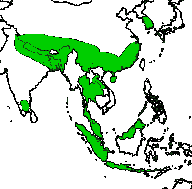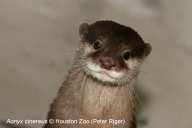|
|
Description
The smallest of the world's otters, about 0.9m long, weighing around
5kg. This otter lives in extended family groups around a breeding alpha
pair. Group sizes of more than 20 animals have been recorded. These
otters are extremely manually dextrous, using their forepaws to feel for
molluscs and crustaceans in rocks, vegetation and mud. They are the
least aquatic of all the otters.
This species used to be known as Amblonyx cinereus, and before
that as Aonyx cinerea. DNA work by Koepfli & Wayne (1998 & 2003)
indicated that the Asian Small-Clawed Otter is a sister species to the
African Clawless and Congo Clawless Otters. Aonyx is the older
name, so the Asian Small-Clawed Otter is now Aonyx cinereus.
CITES Identification Sheet
Habitat
Small-Clawed Otters prefer shallow water, with a good food supply, and
moderate to low bankside vegetation. They demonstrate a high climatic
and trophic adaptability, occurring from tropical coastal wetlands up to
mountain streams. They make use of freshwater and peat swamp forests,
rice fields, lakes, streams, reservoirs, canals, drainage ditches, rice
paddies, mangroves, tidal pools, and along the coastline. In mountainous
areas, they frequent swift-flowing forest streams with rocks and
boulders. Their preferred food is crustaceans and molluscs. Across much
of their range they are sympatric with Eurasian Otters (Lutra lutra),
Smooth-Coated Otters (Lutrogale perspicillata) and Hairy-Nosed
Otters (Lutra sumatrana), and there is clear evidence of niche
separation between the species.
Distribution
Although the species' range appears large, in the last decade, actual
distribution has shrunk, especially in the west, compared to historical
records. They are currently found from the Himalayan foothills of
Himachal Pradesh eastward throughout south Asia, extending up to
Philippines and down through Indonesia. A population which was
previously thought to be isolated, exists in the hill ranges of the
Western Ghats, and more recently they have been reported from protected
areas in the Eastern Ghats which might better explain their distribution
in South India. Their range in the Western Ghats too has increased with
sightings and evidence being reported from the northern Western Ghats,
well extending their range beyond the hills of Coorg and Ashambu. They
were formerly found in Sri Lanka, but their current status there is
unknown. The only areas in which these animals are today known to be
common are Peninsular Malaysia, especially in Kedah, in the western
forests and southern marshes of Thailand, and in the Western Ghats of
India where it appears to be the most common species of otter.
Conservation Status
Red List Category VU (Vulnerable), population decreasing
Year Assessed 2015
Assessor Hussain, S.A. & de Silva, P.K.
Evaluators Conroy, J. (Otter Red List Authority) & Schipper, J. (Global
Mammal Assessment Team)
Current Concerns
The main threat throughout Asian is habitat destruction because of
deforestation (loss of the smaller hill streams), agriculture
(especially tea and coffee plantations in India, draining of peat swamp
forests, and destruction of coastal mangroves for aquaculture) and
settlement. Water courses are being polluted with pesticides from
plantations and other intensive agriculture, and heavy metals, affecting
the gill-feeders on which this species depends, and interfering directly
with otter physiology. Prey biomass is also being reduced by
overexploitation, and in some places, the vast aquaculture industry
regards otters as pests and persecutes them directly. On a more positive
note, there is increased evidence of otters using modified landscapes
such as coffee and tea plantations in India and though habitat
destruction might be of concern, direct threats need to be better
understood. They have even been recorded from storm water drains in
Jakarta, indicating their adaptability to modified habitats. These
otters are known to be highly elusive in disturbed landscapes, and this
could potentially contribute to the perception of a decline in
population.
Although international and national level legal protection is in place,
local legislation is needed. The impact of protection measures on
livelihoods needs to be assessed and answered. Habitat protection and
inter-population corridors need to be established. Research on all aspects
of this species biology and ecology is needed.
Leading Researchers
Source: Padma K de Silva,
IUCN/SSC Asian coordinator
| S.A. Hussain |
|
India |
|
Studies on the range and habitat utilization of small-clawed otter in South India. |
| Aadrean |
|
Indonesia |
|
Studies on diet, interactions with humans and threats including the pet trade in Indonesia |
Key Publications
General
Conservation
-
Foster-Turley, P.A. (1992) Conservation
Aspects of the Ecology of Asian Small-Clawed and Smooth Otters on the
Malay Peninsulas IUCN
Otter Spec. Group Bull. 7:
26 - 29
-
Foster-Turley, P.(1986).
A Progress Report on the Species Survival Plan for Asian Small-Clawed
Otters in United States Zoos. IUCN
Otter Spec. Group Bull. 1:
19 - 21
-
Nugegoda, V. & Matthew, U. (1999).
Reconditioning process of captive-bred oriental small-clawed otters
prior to re-introduction to a mangrove habitat in Singapore. Re-introduction
News 18: 20-21.
-
Perinchery, A., Jathanna, D., Kumar, A. (2011). Factors
determining occupancy and habitat use by Asian small-clawed otters in
the Western Ghats, India.Journal of Mammalogy, 92 (4): 796-802.
-
Prakash N, Mudappa D, Raman TRS, Kumar A (2012).
Conservation of the Asian small-clawed otter (Aonyx cinereus)
in human-modified landscapes, Western Ghats, India. Tropical
Conservation Science 5: 67–78.
-
Mohapatra, P.M., Palei, H.S., & Hussain, S.A., (2014).
Occurrence of Asian small-clawed otter Aonyx cinereus in
Eastern India. Current Science 107(3): 367-370.
-
Punjabi, G.A., Borker, S.A., Mhetar, F., Joshi, D., Kulkarni, R.,
Alave, S.K., & Rao, M.K. (2015).
Recent records of Stripe-necked Mongoose Herpestes vitticollis and
Asian Small-clawed otter Aonyx cinereus from the north Western
Ghats, India. Small Carnivore Conservation 51:51-55.
Captive Studies: Health
-
Borgwardt, N. & Culik, B.M. (1999).
Asian Small-Clawed Otters (Amblonyx cinerea): Resting And
Swimming Metabolic Rates. Journal of Comparative Physiology B 169:
100-106
-
Calle, P.P. & Robinson, P.T. (1985).
Glucosuria Associated with Renal Calculi in Asian Small-Clawed Otters.Journal
of the American Veterinary Association 187 (11): 1149-1153
-
Calle, P.P. (1988).
Asian Small-Clawed Otter (Aonyx cinerea) Urolithiasis
Prevalence in North America. Zoo Biology 7 (3): 233-242
-
Daengsvang, S. (1973).
First Report on Gnathostoma vietnamicum Le-Van-Hoa 1965 from Urinary
System of Otters (Aonyx cinereus, Illiger) in Thailand. Southeast
Asian Journal of Tropical Medicine and Public Health 4 (1):
63-70
-
Dalton, L.M., Robeck, T.R. & Young, W.G. (1997).
Squamous Cell Carcinoma On The Tongue Of An Asian Small-Clawed Otter (Amblonyx
cinereus). IAAAM Proceedings 28: 136
-
Lewis, J.C.M. (1991).
Reversible Immobilization of Asian Small-Clawed Otters with
Medetomidine and Ketamine.Veterinary Record 128: 86-87
-
Nachtigall, P.E. (1969).
Visual Size Discrimination in the East Asian Clawless Otter (Amblonyx
cinereus) in Air and Under Water. Proceedings Of The Sixth
Annual Conference On Biological Sonar And Diving Mammals pp 83-86
-
Nelson, G.H. (1983).
Urinary Calculi in Two Otters (Amblonyx cinerea). Journal of
Zoo and Wildlife Medicine 14: 72-73
-
Petrini,K.R., Lulich, J.P., Treschei, L. & Nachreiner, R.F. (1999).
Evaluation of Urinary and Serum Metabolites in Asian Small-Clawed
Otters (Aonyx cinerea) with Calcium Oxalate Urolithiasis. J
Wildlife Med 30 (1): 54-63
-
Samuals, M.S. & Cook, R.A. (1991).
Electrocardiography of the Asian Small-Clawed Otter (Aonyx cinerea). Zoo
Biology 10 (3): 277-280
-
Warns-Petit, E.S. (2001).
Liver Lobe Torsion in an Oriental Small-Clawed Otter (Aonyx cinerea). Veterinary
Record 148 (7): 212-213
-
Weber, M.A. & Garner, M. ( 2002 ).
Cyanide Toxicosis In Asian Small-Clawed Otters (Amblonyx cinereus)
Secondary To Ingestion Of Loquat (Eriobotrya japonica) Journal
of Zoo and Wildlife Medicine 33 2 : 145 – 146
Captive Studies: Behaviour
-
Nair, S. & Agoramoorthy, G. (2001).
Mating- and Birth-Related Behaviour in Captive Asian Small-Clawed
Otters.International Zoo News 49 (1/14)
[http://www.zoonews.ws/IZN/314/Izn-314.html#otters]
-
Pellis, S.M. (1984).
Two Aspects of Play-Fighting in a Captive Group of Oriental
Small-Clawed Otters Amblonyx cinerea. Zeitschrift f�r
Tierpsychologie 65: 77-83
-
Prima, C.L. (1992).
Weaning Behaviour in the Oriental Small-Clawed Otter Aonyx cinerea at
the National Zoological Park, Washington, D.C.. International Zoo
Year Book 31: 245-250
Taxonomy
-
Koepfli KP, Wayne RK (2003). Type
I STS markers are more informative than cytochrome B in phylogenetic
reconstruction of the Mustelidae (Mammalia: Carnivora). Syst. Biol. 52 (5):
571–93.doi:10.1080/10635150390235368. PMID
14530127.
-
Koepfli, K.-P., R.K. Wayne 1998.
Phylogenetic relationships of otters (Carnivora: Mustelidae) based on
mitochondrial cytochrome b sequences. Journal of the
Zoological Society of London 246, 401-416
Threats
TRAFFIC, 9th December 2009: Otters feel the heat in Southeast Asia
Useful Links
|





